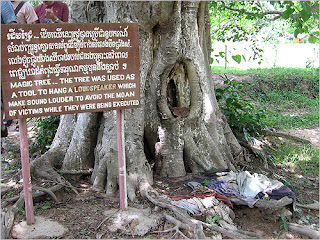 "Magic Tree" on which a loudspeaker was used to drown out victims' cries. Trees were also used to bash people's heads. (Photo: Joan Dawson)
"Magic Tree" on which a loudspeaker was used to drown out victims' cries. Trees were also used to bash people's heads. (Photo: Joan Dawson)Tourists can learn about country's horrific past
2007-06-15
By Joan Dawson
Posted on OhmyNews.com (South Korea)
"Those who cannot remember the past are condemned to repeat it" - George SantayanaCambodia conjures up two things in most people's minds: the beautiful ancient temples of Angkor Wat and the horrific history of the killing fields. The striking contrast is visibly seen when one visits the rich, vast temples of the Angkor empire and then visits the S-21 prison, Choeung Ek killing fields, or the killing cave outside of Battambang. Indeed, just to go from the architectually significant temples to the landscape outside -- dirt roads pitted with potholes, shacks, and chaotic traffic -- one witnesses the impact of this country's violent history. Pol Pot's regime, from 1975 to 1979, left Cambodia severely wounded, but still clinging to life.
Cambodia, situated between Thailand, Laos, and Vietnam, had a population of about 7.3 million when Pol Pot came into power. The country's monarch, Prince Sihanouk, had already been disposed and General Lon Nol had assumed power. Also, the United States and South Vietnamese both entered Cambodia to destroy North Vietnamese bases as the war in Vietnam raged on. In 1975, Phnom Penh, Cambodia's capital, surrendered, and Pol Pot took the helm.
Peace, however, was not to come. Instead, Pol Pot's Khmer Rouge turned the country into a giant slave labor camp and tortured and executed nearly 2 million people, including foreigners, men, women, and children. Many more died of disease or starvation.
Tuol Sleng, or S-21, located in Phnom Penh, is part of the "genocidal trail." It's the torture and detention center where the Khmer regime detained "suspicious" citizens. S-21 had innocently started as a high school called Tuol Svay Prey before Pol Pot's regime turned it into a secret center of torture in 1976. During the regime, it was enclosed by iron sheets and electric barbed wire and the nearby houses were used as administrative offices.
S-21 had about 1,720 workers, most of whom were forced to work, along with children 10-15 years old who worked, untrained, as medical personnel or as general workers.
Documents record 10,499 people who were detained at S-21, but many documents disappeared and the number does not reflect the number of children killed -- estimated at 2,000. The prisoners came from all walks of life: diplomats, intellectuals, farmers, wives, even babies. Most spent two to four months confined to a cell 0.8 by 2 meters, shackled to the wall. Before being taken to their cell, they were photographed.
Today, S-21 stands as a genocidal museum and is filled with the eerie faces of those detained. Most stare vacantly. One wonders of their experience and their death. It's not difficult to imagine as some of the torture implements still remain as evidence of their inhumane treatment.
Outside the former high school stands the gallows. There, victims had their hands tied behind their backs and were hung upside down. They lost consciousness, only to be awakened by having their heads dunked into large jars of foul, dirty water.
There also remains a list of rules the detainees were to follow, such as obeying the officers. For example, they had to ask permission to relieve themselves. If they didn't, they were beaten or whipped.
They bathed collectively and only sporadically. Thus they suffered from skin rashes and infectious diseases.
Many of the detainees were then taken to Choeung Ek, known as the killing fields, 14 km. outside of Phnom Penh. About 20,000 people were killed in these fields. Today, it is a museum. It's eerily quiet, but nearby is a school where the collective sounds of children can be heard laughing and playing, a testament to the resiliency of humans.
At the center of the fields is a stupa that houses over 8,000 skulls. To save on bullets, the Khmer Rouge would often use blunt instruments or bashing, as evidenced by some of the skulls. Behind the stupa are the mass graves. Tattered pieces of clothing are still found three decades later, interwoven with the soft brown earth.
 Choeung Ek Genocidal Center: over 8,000 skulls bear testimony to unspeakable crimes (Photo: Joan Dawson)
Choeung Ek Genocidal Center: over 8,000 skulls bear testimony to unspeakable crimes (Photo: Joan Dawson)Further up north, outside the town of Battambang, is Phnom Sampeau. There, the Khmer Rouge would fling people, adults and children, down the cave's vertical entrance, in their effort to save bullets. The atrocity of such actions is overwhelming and simply bewildering.
Today, tourists visit Cambodia's genocidal trail. Some call it macabre, others educational. The Tuol Sleng genocide museum opened in 1980 and receives about 50 visitors a day, on average. They rely on grants and individual donations. They still require funding for repairs, building a fence and preserving important historical documents from pests and humidity. Thus, although some believe money shouldn't be made on such atrocious crimes, tourist dollars are helping to preserve history.
More tourists are expected to visit Cambodia's genocidal trail in the future as trials, after being delayed, are expected to start in 2008. Pol Pot died in 1998 and others from his regime live freely. Not a single person has been brought to trial to date.






























1 comment:
The past are not allowed to be taught to Cambodia children by the current government. We need to get rid of the government in order for us to teach our children of our horrifying past. If they are taught, the mistake will not repeat itself.
Post a Comment